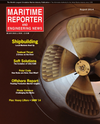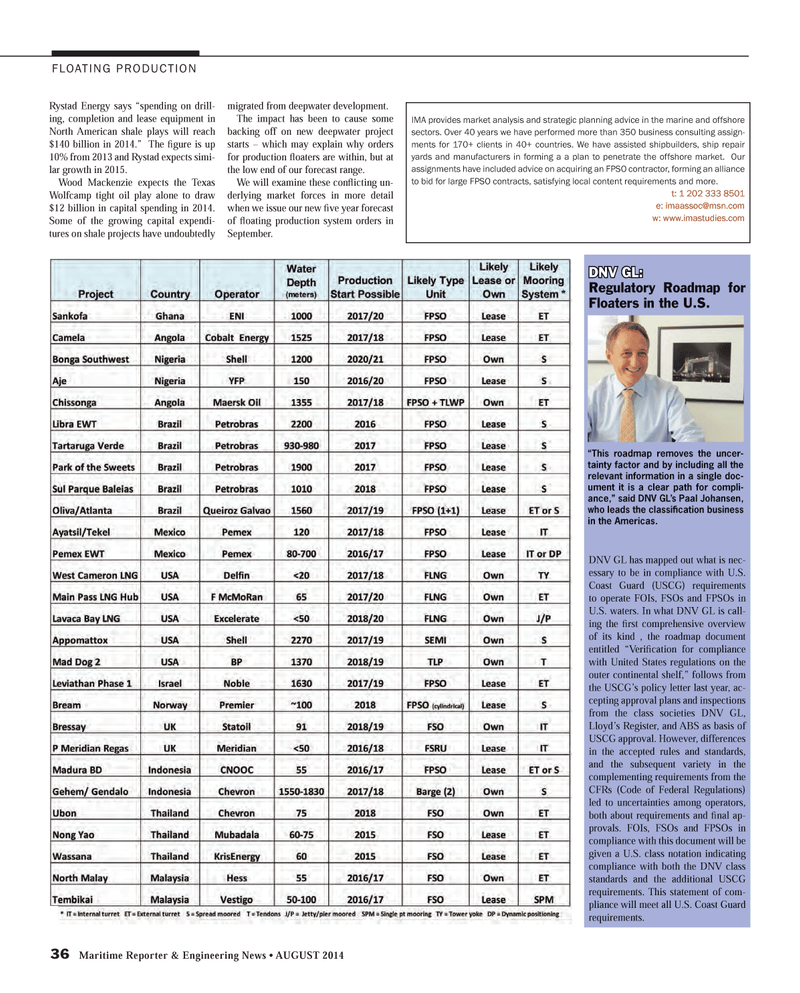
Page 36: of Maritime Reporter Magazine (August 2014)
Shipyard Edition
Read this page in Pdf, Flash or Html5 edition of August 2014 Maritime Reporter Magazine
36 Maritime Reporter & Engineering News ? AUGUST 2014 Rystad Energy says ?spending on drill- ing, completion and lease equipment in North American shale plays will reach $140 billion in 2014.? The Þ gure is up 10% from 2013 and Rystad expects simi- lar growth in 2015. Wood Mackenzie expects the Texas Wolfcamp tight oil play alone to draw $12 billion in capital spending in 2014. Some of the growing capital expendi-tures on shale projects have undoubtedly migrated from deepwater development.The impact has been to cause some backing off on new deepwater project starts ? which may explain why orders for production ß oaters are within, but at the low end of our forecast range. We will examine these con ß icting un- derlying market forces in more detail when we issue our new Þ ve year forecast of ß oating production system orders in September. FLOATING PRODUCTION IMA provides market analysis and strategic planning advice in the marine and offshore sectors. Over 40 years we have performed more than 350 business consulting assign- ments for 170+ clients in 40+ countries. We have assisted shipbuilders, ship repair yards and manufacturers in forming a a plan to penetrate the offshore market. Our assignments have included advice on acquiring an FPSO contractor, forming an alliance to bid for large FPSO contracts, satisfying local content requirements and more. t: 1 202 333 8501 e: [email protected] w: www.imastudies.comDNV GL: DNV GL: Regulatory Roadmap for Floaters in the U.S.DNV GL has mapped out what is nec- essary to be in compliance with U.S. Coast Guard (USCG) requirements to operate FOIs, FSOs and FPSOs in U.S. waters. In what DNV GL is call- ing the Þ rst comprehensive overview of its kind , the roadmap document entitled ?Veri Þ cation for compliance with United States regulations on the outer continental shelf,? follows from the USCG?s policy letter last year, ac- cepting approval plans and inspections from the class societies DNV GL, Lloyd?s Register, and ABS as basis of USCG approval. However, differences in the accepted rules and standards, and the subsequent variety in the complementing requirements from the CFRs (Code of Federal Regulations) led to uncertainties among operators, both about requirements and Þ nal ap- provals. FOIs, FSOs and FPSOs in compliance with this document will be given a U.S. class notation indicating compliance with both the DNV class standards and the additional USCG requirements. This statement of com- pliance will meet all U.S. Coast Guard requirements.?This roadmap removes the uncer- tainty factor and by including all the relevant information in a single doc- ument it is a clear path for compli-ance,? said DNV GL?s Paal Johansen, who leads the classi cation business in the Americas.MR #8 (34-41).indd 36MR #8 (34-41).indd 368/4/2014 11:17:15 AM8/4/2014 11:17:15 AM

 35
35

 37
37
